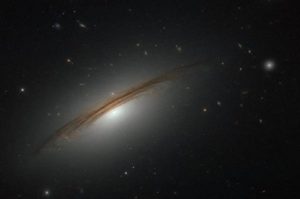
NASA’s Hubble space telescope has captured a new picture of a massive galaxy UGC 12591 located 400 million light-years away from Earth. According to NASA, this hybrid galaxy has characteristics of both lenticular and a spiral galaxies.
The galaxy is located in the westernmost part of the Pisces–Perseus Supercluster— one of the largest known structures in the cosmos. It is basically a long chain of galaxy clusters and stretches out for hundreds of light-years.
According to NASA, the mass of UGC 12591 galaxy and its halo is about four times that of the Milky Way and several hundred billion times the mass of the Sun. This galaxy rotates at speeds of up to 1.8 million kilometers per hour.
NASA astronomers are using Hubble to determine whether UGC 12591 grew slowly over time or whether it gained so much mass by colliding and merging with another large galaxy.
Other Discoveries Made Using Hubble
Last month, scientists had announced to have discovered a white dwarf star about 170 light years from the Earth using NASA’s Hubble space telescope.
In this study, the astronomers focused on WD 1425+540 white dwarf star, but found evidence that the planetary system of this star contains ingredients or basic building blocks of life.
In May last year, scientists from Massachusetts Institute of Technology, the University of Liège, and other schools announced that they used NASA’s Hubble Space Telescope to discover a planetary system hosting three potentially habitable planets. NASA’s Hubble Space Telescope was used to catch the rare event of a double transit, with two planets passing nearly in tandem in front of their star – TRAPPIST-1, located 40 light years from Earth.